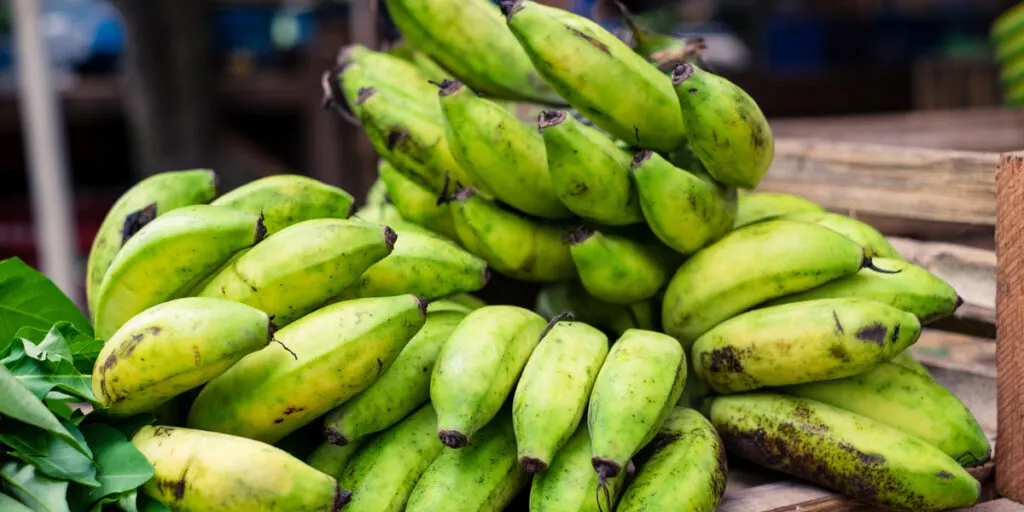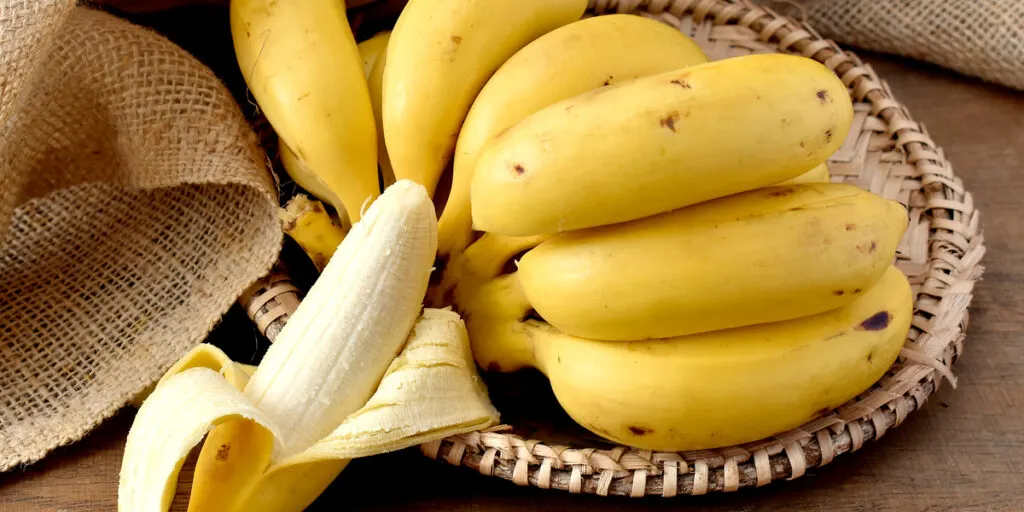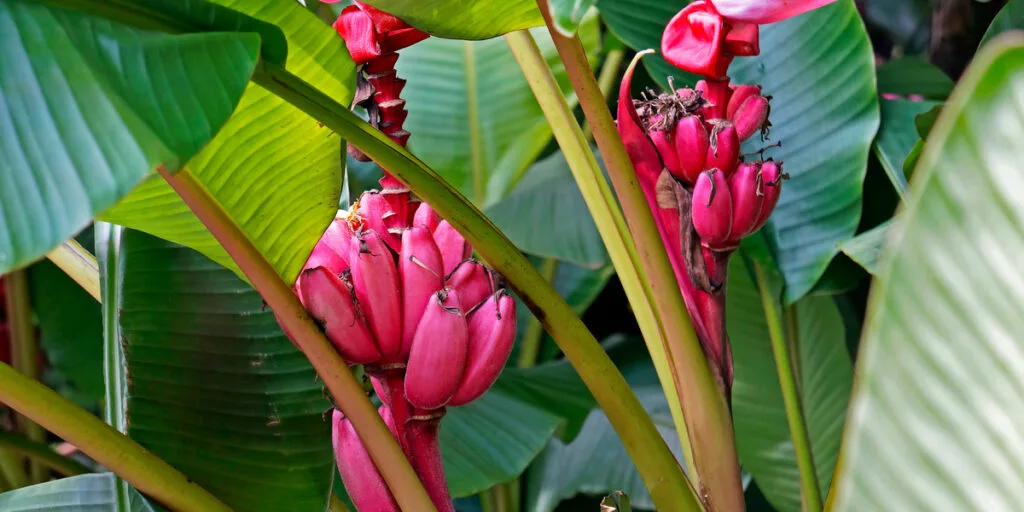The hot weather in Florida offers many benefits to people from all over the United States. One of these benefits is bananas. Florida is close to the tropics, and the abundance of water there creates a humid, semi-tropical climate.
In a tropical climate, you can grow plants that love the hot weather and the exposure to full sun. One of those plants would be bananas.
But not all bananas are created equal. Some can only grow in tropical countries, while others can grow in a semi-tropical region like Florida. With that said, here are 10 types of bananas that you can find in Florida.
Table of Contents
1. Dwarf Cavendish (Musa acuminata)

Originating from the first banana tree that grew in a hothouse in the northern United Kingdom in the 1800s, the Dwarf Cavendish banana is one of the varieties that you can find in Florida.
Since its first cultivation, this variety has been shipped and exported to many countries worldwide, including Southeast Asia, West Africa, Australia, Madagascar, and the Canary Islands.
These bananas are dwarf plants that grow between 3 and 10 feet tall. Dwarf Cavendish bananas can be recognized by their large, flat leaves with short petioles and yellow to white flowers that grow in clusters.
Their fruits are green but turn yellow when they mature. They generally measure between 6 and 10 inches in length. These bananas are edible and easy to grow. Being a dwarf variety, they can be grown indoors or outdoors.
2. Goldfinger Banana (FHIA-01)
Goldfinger bananas are a special variety of banana that was developed in Honduras. They are a hybrid product from a cross between these three cultivars; Musa acuminata x balnisiana, Prata-ana, and the SH-3142.
These banana plants generally grow between 3 and 8 feet tall and take a longer time to mature. At most, they can grow up to 14 feet tall. Goldfinger bananas produce long, green fruits measuring between 6 and 8 inches long. Their fruits have an apple-like taste.
Unlike some varieties, Goldfinger bananas can withstand cold and harsh weather. They are also resistant to major banana diseases such as Panama and Sigatoka diseases. Goldfinger bananas thrive in moist, well-drained soils and in full sun.
3. Silk Banana (Musa acuminata x balbisiana (AAB Group))

Also known as the Lantundan bananas, Pisang Raja, or Tundan, this cultivar is the most common banana that you can find in Southeast Asia and the Philippines. They were named after a French clergyman, Claude Letondal, who brought them to India.
Silk bananas generally grow between 10 and 13 feet tall. They can be recognized by their large, oval-shaped green leaves with a yellow or light green midvein.
These plants produce round-tipped, yellow fruits with thin skin that breaks when they mature. The fruits are slightly acidic with an apple-like taste. With enough supply of moisture in the soil, silk bananas can thrive under full sun.
4. Mona Lisa Banana (FHIA-2)
The Mona Lisa banana, or FHIA-2, is a hybrid cultivar known for its high resistance to pests and major banana diseases. Originating from Lima, Honduras, this hybrid cultivar grows between 10 and 12 feet tall. These bananas can be recognized by their green foliage and green fruits that turn yellow when they mature.
Aside from their resilience to diseases, the tree bark and roots of this variety are strong enough to withstand windy seasons and harsh weather. Mona Lisa bananas also taste milder than most varieties.
Mona Lisa bananas thrive in moist, well-drained soil and under full sun. As long as they receive enough nutrients, water, and sunlight, this variety can be grown both indoors and outdoors.
5. Lady Finger Banana (Musa acuminata ‘Lady Finger‘)

Also known as Chinese bananas, fig bananas, sugar bananas, and date bananas, these herbaceous perennials are actually a dwarf version of the Cavendish cultivar. They are known to be the second most popular bananas in Australia and are grown as ornamental plants during their early and dwarf stage.
In some cases, Lady Finger banana plants can grow up to 23 feet tall, provided that they receive ample nutrients, water, and sunlight. The fruits from this variety generally measure between 4 and 5 inches long. They are easily recognized by their thin skins and cigar-like shape.
With their bright yellow fruits, this variety produces sweet fruits that don’t oxidize quickly when the skins are cut. Like most bananas, Lady Finger bananas thrive in moist, well-drained soil and under full sun.
6. Rajapuri Banana (Musa ‘Rajapuri‘)
Rajapuri bananas originated in India and have been introduced into the United States as specialty cultivars. These plants generally grow between 10 and 12 feet tall and are resistant to strong wind and cold weather.
In Florida, Rajapuri bananas are considered one of the best varieties for landscape gardening. As a matter of fact, in their native land of India, these compact perennials are also primarily grown as ornamental plants in many home gardens.
Rajapuri bananas can be recognized by their small- to medium-sized fruits that measure between 5 and 6 inches. They have large, green leaves that can grow up to 3 feet wide.
This variety is easy to grow, and it doesn’t need too much attention. Unlike other varieties, they can survive in poor soil, under full sun, or even partial shade.
7. Japanese Fiber Banana (Musa basjoo)

Also known as Japanese bananas or hardy bananas, these bananas are native to the Sichuan province and subtropical southern China. They generally grow between 10 and 15 feet tall. This variety can also be recognized by its large cream to yellow flowers and green, paddle-shaped leaves that can grow up to 10 feet long and 2 feet wide.
Japanese fiber bananas are grown as ornamental plants in many countries including Japan, the United Kingdom, southern Canada, and the United States. They produce inedible yellow-green fruits that measure between 2 and 4 inches long.
Although their fruits can’t be consumed, these plants are useful in many other ways. For instance, the Japanese will use the fiber from these plants to produce textiles known as kijoka-bashofu. In China, the flower, stem, leaves, and rhizomes of Japanese Fiber bananas are used as medicinal herbs.
8. Honey Banana (Musa johnsii)
Honey bananas are a unique and wild variety that is native to western New Guinea. They generally grow between 10 and 13 feet tall and have large, green leaves that can grow up to 8 feet long.
These plants can be recognized by their red to pink flowers and bright yellow-orange fruits that can be seen from afar.
The fruits of honey bananas are categorized as schizocarpic fruits, which refers to the way the fruits break and expose the pulp when they mature.
Honey bananas thrive in a partial shade. They shouldn’t be grown in an open space or under constant exposure to full sun.
9. Pink Velvet Banana (Musa velutina)

Pink velvet bananas are native to Southeast Asia, particularly to the eastern Himalayas; Assam, India; and Australia. This diploid species of wild banana is also known as a pink banana or hairy banana.
They can also be recognized by their yellowish- to purplish-green pseudostems, yellow flowers, pink bracts, and large, oblong-shaped leaves. Pink velvet bananas generally grow between 5 and 8 feet tall, with foliage branching between 3 and 5 feet. They produce pink, hairy fruits that measure around 3 inches long.
Being hardy, pink velvet bananas are resistant to pests, major diseases, and harsh weather. It takes only around one year for this variety to mature and bloom. However, they might need around 5 to 10 years to reach their full height.
10. Thai Black Banana (Musa balbisiana)
Also known as the Musa “Thai Black” or black-stemmed bananas, this variety can be recognized by their large but narrow leaves and glossy green pseudostem or trunk that would turn brownish-black or dark purplish when mature.
Thai black banana plants generally grow between 7 and 10 feet tall but can grow up to 20 feet tall. Being an ornamental breed, their fruits aren’t edible. Thai black bananas are resistant to extreme weather, pest, and major banana diseases.
Thai black bananas are easy to grow and thrive under full sun. You can grow these bananas indoors, in large pots, or in your garden.
Final Thoughts
If you’re living in Florida and are looking to grow these perennial tropical plants, be sure to provide your chosen varieties with all the nutrients they need.
Most importantly, the environment they live in also needs to be conducive. They can live under full sun, provided that they are given enough water to stay hydrated. Lastly, avoid planting bananas on hills or valleys to avoid the extreme wind or cold temperatures, especially in the rainy season.
Citations
- https://ediblesouthflorida.ediblecommunities.com/eat/know-your-bananas
- https://gardeningsolutions.ifas.ufl.edu/plants/edibles/fruits/bananas.html
- https://discover.pbcgov.org/coextension/ArticleArchives/GrowingBananas.pdf
- https://askthegreengenie.com/tropical-fruits/yes-we-have-no-banana-tree-plants/
- https://www.nparks.gov.sg/florafaunaweb/flora/8/0/8036
- https://www.agristarts.com/index.cfm/fuseaction/plants.plantDetail/plant_ID/72/index.htm
- https://www.nparks.gov.sg/florafaunaweb/flora/6/6/6668
- https://floridahillnursery.com/plants/banana-plants-for-sale/banana-plant-mona-lisa-musa-banana-tree/
- https://specialtyproduce.com/produce/Lady_Finger_Bananas_14422.php
- https://specialtyproduce.com/produce/Rajapuri_Bananas_11286.php
- https://en.wikipedia.org/wiki/Musa_basjoo
- https://www.quintadosouriques.com/store/seeds/fruits/musa-bananas/honey-banana-banana-silvestre-from-papua-new/
- https://plantcaretoday.com/pink-banana.html
- https://www.agristarts.com/index.cfm/fuseaction/plants.plantDetail/plant_ID/84/index.htm
